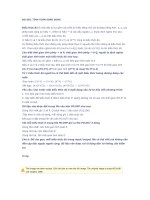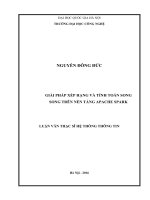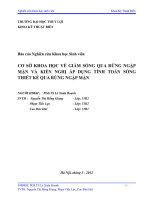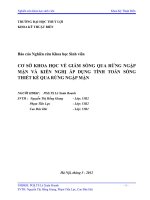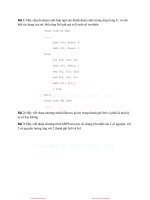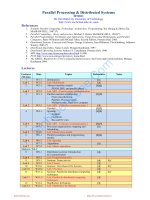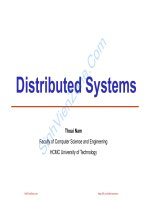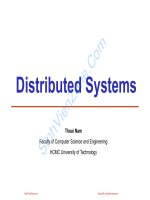tính toán song song thoại nam parallelprocessing 12 basicparallelalgorithms sinhvienzone com
Bạn đang xem bản rút gọn của tài liệu. Xem và tải ngay bản đầy đủ của tài liệu tại đây (549.3 KB, 30 trang )
om
Si
nh
Vi
en
Zo
ne
.C
Parallel Algorithms
SinhVienZone.com
Thoai Nam
/>
om
Outline
to parallel algorithms
development
Reduction algorithms
Broadcast algorithms
Prefix sums algorithms
Si
nh
Vi
en
Zo
ne
.C
Introduction
/>Khoa Coõng Ngheọ Thoõng Tin ẹaùi Hoùc Baựch Khoa
Tp.HCM
SinhVienZone.com
-2-
Introduction to Parallel
Algorithm Development
om
Parallel algorithms mostly depend on destination
parallel platforms and architectures
MIMD algorithm classification
According to M.J.Quinn (1994), there are 7 design
strategies for parallel algorithms
Si
Zo
Pre-scheduled data-parallel algorithms
Self-scheduled data-parallel algorithms
Control-parallel algorithms
nh
Vi
en
ne
.C
/>Khoa Coõng Ngheọ Thoõng Tin ẹaùi Hoùc Baựch Khoa
Tp.HCM
SinhVienZone.com
-3-
Target Architectures
nh
Vi
en
ne
Reduction
Broadcast
Prefix sums
Zo
.C
3 elementary problems to be considered
Hypercube SIMD model
2D-mesh SIMD model
UMA multiprocessor model
Hypercube Multicomputer
Si
om
Basic Parallel Algorithms
/>Khoa Coõng Ngheọ Thoõng Tin ẹaùi Hoùc Baựch Khoa
Tp.HCM
SinhVienZone.com
-4-
Description: Given n values a0, a1, a2an-1
associative operation , lets use p processors
to compute the sum:
ne
.C
om
Reduction Problem
Design strategy 1
If a cost optimal CREW PRAM algorithms exists
and the way the PRAM processors interact through
shared variables maps onto the target architecture, a
PRAM algorithm is a reasonable starting point
Si
nh
Vi
en
Zo
S = a0 a1 a2 an-1
/>Khoa Coõng Ngheọ Thoõng Tin ẹaùi Hoùc Baựch Khoa
Tp.HCM
SinhVienZone.com
-5-
om
Cost Optimal PRAM Algorithm
for the Reduction Problem
Cost optimal PRAM algorithm complexity:
Example for n=8 and p=4 processors
a1
a2
a3
a4
a5
a6
a7
P0
j=1
P0
j=2
P0
P1
Si
j=0
nh
Vi
en
Zo
a0
ne
.C
O(logn) (using n div 2 processors)
P2
P3
P2
/>Khoa Coõng Ngheọ Thoõng Tin ẹaùi Hoùc Baựch Khoa
Tp.HCM
SinhVienZone.com
-6-
Cost Optimal PRAM Algorithm for
the Reduction Problem(contd)
om
Using p= n div 2 processors to add n numbers:
nh
Vi
en
Zo
ne
.C
Global a[0..n-1], n, i, j, p;
Begin
spawn(P0, P1, ,,Pp-1);
for all Pi where 0 i p-1 do
for j=0 to ceiling(logp)-1 do
if i mod 2j =0 and 2i + 2j < n then
Si
a[2i] := a[2i] a[2i + 2j];
endif;
endfor j;
endforall;
End.
Notes: the processors communicate in a biominal-tree pattern
/>Khoa Coõng Ngheọ Thoõng Tin ẹaùi Hoùc Baựch Khoa
Tp.HCM
SinhVienZone.com
-7-
nh
Vi
en
P2
P0
P7
P5
P1
Si
P3
Step 1:
Zo
P0
P2
P1
ne
P6
P4
P0
.C
om
Solving Reducing Problem on
Hypercube SIMD Computer
Reduce by dimension j=2
P1
P3
Step 2:
Step 3:
Reduce by dimension j=1
Reduce by dimension j=0
The total sum will be at P0
/>Khoa Coõng Ngheọ Thoõng Tin ẹaùi Hoùc Baựch Khoa
Tp.HCM
SinhVienZone.com
-8-
Solving Reducing Problem on
Hypercube SIMD Computer (condt)
Si
Allocate
workload for
each
processors
nh
Vi
en
Zo
ne
.C
om
Using p processors to add n numbers ( p << n)
Global j;
Local local.set.size, local.value[1..n div p +1], sum,
tmp;
Begin
spawn(P0, P1, ,,Pp-1);
for all Pi where 0 i p-1 do
if (i < n mod p) then local.set.size:= n div p + 1
else local.set.size := n div p;
endif;
sum[i]:=0;
endforall;
/>Khoa Coõng Ngheọ Thoõng Tin ẹaùi Hoùc Baựch Khoa
Tp.HCM
SinhVienZone.com
-9-
Solving Reducing Problem on
Hypercube SIMD Computer (condt)
ne
Zo
sum[i]:= sum local.value [j];
endforall;
endfor j;
Si
nh
Vi
en
Calculate the
partial sum for
each processor
.C
om
for j:=1 to (n div p +1) do
for all Pi where 0 i p-1 do
if local.set.size j then
/>Khoa Coõng Ngheọ Thoõng Tin ẹaùi Hoùc Baựch Khoa
Tp.HCM
SinhVienZone.com
-10-
om
Solving Reducing Problem on
Hypercube SIMD Computer (condt)
.C
ne
Zo
sum := sum tmp;
Si
nh
Vi
en
Calculate the total
sum by reducing
for each
dimension of the
hypercube
for j:=ceiling(logp)-1 downto 0 do
for all Pi where 0 i p-1 do
if i < 2j then
tmp := [i + 2j]sum;
endif;
endforall;
endfor j;
/>Khoa Coõng Ngheọ Thoõng Tin ẹaùi Hoùc Baựch Khoa
Tp.HCM
SinhVienZone.com
-11-
.C
ne
Zo
Example: a 4*4 mesh
need 2*3 steps to get
the subtotals from the
corner processors
nh
Vi
en
A 2D-mesh with p*p processors need at least 2(p-1) steps to
send data between two farthest nodes
The lower bound of the complexity of any reduction sum
algorithm is 0(n/p2 + p)
Si
om
Solving Reducing Problem on
2D-Mesh SIMD Computer
/>Khoa Coõng Ngheọ Thoõng Tin ẹaùi Hoùc Baựch Khoa
Tp.HCM
SinhVienZone.com
-12-
nh
Vi
en
Zo
ne
.C
Example: compute the total sum on a 4*4 mesh
Stage 1
Si
om
Solving Reducing Problem on
2D-Mesh SIMD Computer(contd)
Step i = 3
Stage 1
Stage 1
Step i = 2
Step i = 1
/>Khoa Coõng Ngheọ Thoõng Tin ẹaùi Hoùc Baựch Khoa
Tp.HCM
SinhVienZone.com
-13-
Stage 2
nh
Vi
en
Zo
ne
.C
Example: compute the total sum on a 4*4 mesh
Si
om
Solving Reducing Problem on
2D-Mesh SIMD Computer(contd)
Step i = 3
Stage 2
Stage 2
Step i = 2
Step i = 1
(the sum is at P1,1)
/>Khoa Coõng Ngheọ Thoõng Tin ẹaùi Hoùc Baựch Khoa
Tp.HCM
SinhVienZone.com
-14-
Solving Reducing Problem on
2D-Mesh SIMD Computer(contd)
Stage 1:
sum:= sum tmp;
end forall;
endfor;
Si
Pi,1 computes
the sum of all
processors in
row i-th
nh
Vi
en
Zo
ne
.C
om
Summation (2D-mesh SIMD with l*l processors
Global i;
Local tmp, sum;
Begin
{Each processor finds sum of its local value
code not shown}
for i:=l-1 downto 1 do
for all Pj,i where 1 i l do
{Processing elements in colum i active}
tmp := right(sum);
/>Khoa Coõng Ngheọ Thoõng Tin ẹaùi Hoùc Baựch Khoa
Tp.HCM
SinhVienZone.com
-15-
Solving Reducing Problem on
2D-Mesh SIMD Computer(contd)
om
.C
ne
sum:=sum tmp;
end forall;
endfor;
End.
Si
nh
Vi
en
Compute the
total sum and
store it at P1,1
Zo
Stage2:
for i:= l-1 downto 1 do
for all Pi,1 do
{Only a single processing element active}
tmp:=down(sum);
/>Khoa Coõng Ngheọ Thoõng Tin ẹaùi Hoùc Baựch Khoa
Tp.HCM
SinhVienZone.com
-16-
.C
ne
Global
a[0..n-1],
p,
Zo
{values to be added}
nh
Vi
en
Easily to access data like PRAM
Processors execute asynchronously, so we must ensure
that no processor access an unstable variable
Variables used:
{number of proeessor, a power of 2}
flags[0..p-1],
{Set to 1 when partial sum available}
partial[0..p-1],
{Contains partial sum}
Si
om
Solving Reducing Problem on
UMA Multiprocessor Model(MIMD)
{Result stored here}
global_sum;
Local local_sum;
/>Khoa Coõng Ngheọ Thoõng Tin ẹaùi Hoùc Baựch Khoa
Tp.HCM
SinhVienZone.com
-17-
Example for UMA multiprocessor with p=8 processors
P2
P3
P4
P5
P6
P7
Zo
ne
P1
.C
P0
Stage 2
nh
Vi
en
Step j=8
Step j=4
Step j=2
Si
om
Solving Reducing Problem on
UMA Multiprocessor Model(contd)
The total sum is at P0
Step j=1
/>Khoa Coõng Ngheọ Thoõng Tin ẹaùi Hoùc Baựch Khoa
Tp.HCM
SinhVienZone.com
-18-
Solving Reducing Problem on UMA
Multiprocessor Model(contd)
ne
Si
nh
Vi
en
Each processor
computes the
partial sum of n/p
values
Zo
Stage 1:
.C
om
Summation (UMA multiprocessor model)
Begin
for k:=0 to p-1 do flags[k]:=0;
for all Pi where 0 i < p do
local_sum :=0;
for j:=i to n-1 step p do
local_sum:=local_sum a[j];
/>Khoa Coõng Ngheọ Thoõng Tin ẹaùi Hoùc Baựch Khoa
Tp.HCM
SinhVienZone.com
-19-
Solving Reducing Problem on UMA
Multiprocessor Model(contd)
.C
om
j:=p;
while j>0 do begin
ne
nh
Vi
en
Compute the total sum
Zo
Stage 2:
if i j/2 then
partial[i]:=local_sum;
flags[i]:=1;
break;
else
while (flags[i+j/2]=0) do;
local_sum:=local_sum partial[i+j/2];
endif;
j=j/2;
end while;
if i=0 then global_sum:=local_sum;
end forall;
End.
Si
Each processor
waits for the partial
sum of its partner
available
/>Khoa Coõng Ngheọ Thoõng Tin ẹaùi Hoùc Baựch Khoa
Tp.HCM
SinhVienZone.com
-20-
om
Solving Reducing Problem on UMA
Multiprocessor Model(contd)
Algorithm complexity 0(n/p+p)
What is the advantage of this algorithm compared
with another one using critical-section style to
compute the total sum?
Design strategy 2:
nh
Vi
en
Zo
ne
.C
Look for a data-parallel algorithm before considering a
control-parallel algorithm
Si
On MIMD computer, we should exploit both data
parallelism and control parallelism
(try to develop SPMD program if possible)
/>Khoa Coõng Ngheọ Thoõng Tin ẹaùi Hoùc Baựch Khoa
Tp.HCM
SinhVienZone.com
-21-
Description:
.C
Zo
Things to be considered:
Length of the message
Message passing overhead and data-transfer time
nh
Vi
en
Given a message of length M stored at one processor,
lets send this message to all other processors
ne
Si
om
Broadcast
/>Khoa Coõng Ngheọ Thoõng Tin ẹaùi Hoùc Baựch Khoa
Tp.HCM
SinhVienZone.com
-22-
.C
P0
nh
Vi
en
P0
P1
Si
Step 1:
P1
Send the number via the
1st dimension of the
hypercube
P2
P0
P2
P7
P5
P3
P1
P3
Step 2:
Step 3:
Send the number via the
2nd dimension of the
hypercube
Send the number via the
3rd dimension of the
hypercube
/>Khoa Coõng Ngheọ Thoõng Tin ẹaùi Hoùc Baựch Khoa
Tp.HCM
SinhVienZone.com
P6
P4
ne
If the amount of data is small, the best algorithm takes logp
communication steps on a p-node hypercube
Examples: broadcasting a number on a 8-node hypercube
Zo
om
Broadcast Algorithm on
Hypercube SIMD
-23-
Broadcast Algorithm on
Hypercube SIMD(contd)
i,
{Loop iteration}
p,
{Partner processor}
position; {Position in broadcast tree}
value; {Value to be broadcast}
ne
.C
Local
om
Broadcasting a number from P0 to all other processors
Si
nh
Vi
en
Zo
Begin
spawn(P0, P1, ,,Pp-1);
for j:=0 to logp-1 do
for all Pi where 0 i p-1 do
if i < 2j then
partner := i+2j;
[partner]value:=value;
endif;
endforall;
end forj;
End.
/>Khoa Coõng Ngheọ Thoõng Tin ẹaùi Hoùc Baựch Khoa
Tp.HCM
SinhVienZone.com
-24-
om
Broadcast Algorithm on
Hypercube SIMD(contd)
The previous algorithm
Uses at most p/2 out of plogp links of the hypercube
Requires time Mlogp to broadcast a length M msg
not efficient to broadcast long messages
nh
Vi
en
Johhsson and Ho (1989) have designed an
algorithm that executes logp times faster by:
Breaking the message into logp parts
Broadcasting each parts to all other nodes through a
different biominal spanning tree
Si
Zo
ne
.C
/>Khoa Coõng Ngheọ Thoõng Tin ẹaùi Hoùc Baựch Khoa
Tp.HCM
SinhVienZone.com
-25-
